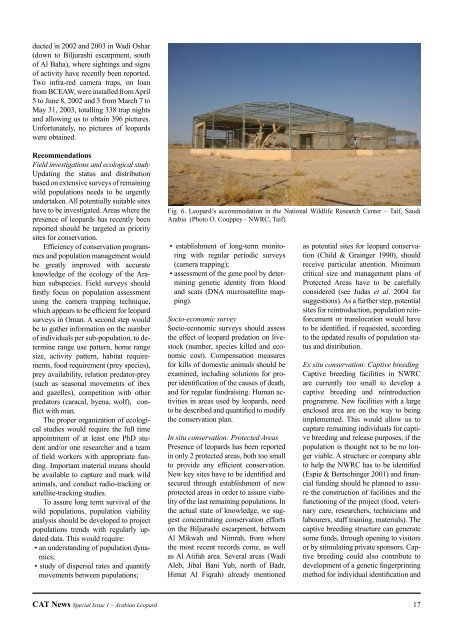Status and Conservation of the Leopard on the Arabian Peninsula ...
Status and Conservation of the Leopard on the Arabian Peninsula ...
Status and Conservation of the Leopard on the Arabian Peninsula ...
You also want an ePaper? Increase the reach of your titles
YUMPU automatically turns print PDFs into web optimized ePapers that Google loves.
ducted in 2002 <str<strong>on</strong>g>and</str<strong>on</strong>g> 2003 in Wadi Oshar<br />
(down to Biljurashi escarpment, south<br />
<str<strong>on</strong>g>of</str<strong>on</strong>g> Al Baha), where sightings <str<strong>on</strong>g>and</str<strong>on</strong>g> signs<br />
<str<strong>on</strong>g>of</str<strong>on</strong>g> activity have recently been reported.<br />
Two infra-red camera traps, <strong>on</strong> loan<br />
from BCEAW, were installed from April<br />
5 to June 8, 2002 <str<strong>on</strong>g>and</str<strong>on</strong>g> 3 from March 7 to<br />
May 31, 2003, totalling 338 trap nights<br />
<str<strong>on</strong>g>and</str<strong>on</strong>g> allowing us to obtain 396 pictures.<br />
Unfortunately, no pictures <str<strong>on</strong>g>of</str<strong>on</strong>g> leopards<br />
were obtained.<br />
Recommendati<strong>on</strong>s<br />
Field investigati<strong>on</strong>s <str<strong>on</strong>g>and</str<strong>on</strong>g> ecological study<br />
Updating <str<strong>on</strong>g>the</str<strong>on</strong>g> status <str<strong>on</strong>g>and</str<strong>on</strong>g> distributi<strong>on</strong><br />
based <strong>on</strong> extensive surveys <str<strong>on</strong>g>of</str<strong>on</strong>g> remaining<br />
wild populati<strong>on</strong>s needs to be urgently<br />
undertaken. All potentially suitable sites<br />
have to be investigated. Areas where <str<strong>on</strong>g>the</str<strong>on</strong>g><br />
presence <str<strong>on</strong>g>of</str<strong>on</strong>g> leopards has recently been<br />
reported should be targeted as priority<br />
sites for c<strong>on</strong>servati<strong>on</strong>.<br />
Efficiency <str<strong>on</strong>g>of</str<strong>on</strong>g> c<strong>on</strong>servati<strong>on</strong> programmes<br />
<str<strong>on</strong>g>and</str<strong>on</strong>g> populati<strong>on</strong> management would<br />
be greatly improved with accurate<br />
knowledge <str<strong>on</strong>g>of</str<strong>on</strong>g> <str<strong>on</strong>g>the</str<strong>on</strong>g> ecology <str<strong>on</strong>g>of</str<strong>on</strong>g> <str<strong>on</strong>g>the</str<strong>on</strong>g> <strong>Arabian</strong><br />
subspecies. Field surveys should<br />
firstly focus <strong>on</strong> populati<strong>on</strong> assessment<br />
using <str<strong>on</strong>g>the</str<strong>on</strong>g> camera trapping technique,<br />
which appears to be efficient for leopard<br />
surveys in Oman. A sec<strong>on</strong>d step would<br />
be to ga<str<strong>on</strong>g>the</str<strong>on</strong>g>r informati<strong>on</strong> <strong>on</strong> <str<strong>on</strong>g>the</str<strong>on</strong>g> number<br />
<str<strong>on</strong>g>of</str<strong>on</strong>g> individuals per sub-populati<strong>on</strong>, to determine<br />
range use pattern, home range<br />
size, activity pattern, habitat requirements,<br />
food requirement (prey species),<br />
prey availability, relati<strong>on</strong> predator-prey<br />
(such as seas<strong>on</strong>al movements <str<strong>on</strong>g>of</str<strong>on</strong>g> ibex<br />
<str<strong>on</strong>g>and</str<strong>on</strong>g> gazelles), competiti<strong>on</strong> with o<str<strong>on</strong>g>the</str<strong>on</strong>g>r<br />
predators (caracal, hyena, wolf), c<strong>on</strong>flict<br />
with man.<br />
The proper organizati<strong>on</strong> <str<strong>on</strong>g>of</str<strong>on</strong>g> ecological<br />
studies would require <str<strong>on</strong>g>the</str<strong>on</strong>g> full time<br />
appointment <str<strong>on</strong>g>of</str<strong>on</strong>g> at least <strong>on</strong>e PhD student<br />
<str<strong>on</strong>g>and</str<strong>on</strong>g>/or <strong>on</strong>e researcher <str<strong>on</strong>g>and</str<strong>on</strong>g> a team<br />
<str<strong>on</strong>g>of</str<strong>on</strong>g> field workers with appropriate funding.<br />
Important material means should<br />
be available to capture <str<strong>on</strong>g>and</str<strong>on</strong>g> mark wild<br />
animals, <str<strong>on</strong>g>and</str<strong>on</strong>g> c<strong>on</strong>duct radio-tracking or<br />
satellite-tracking studies.<br />
To assure l<strong>on</strong>g term survival <str<strong>on</strong>g>of</str<strong>on</strong>g> <str<strong>on</strong>g>the</str<strong>on</strong>g><br />
wild populati<strong>on</strong>s, populati<strong>on</strong> viability<br />
analysis should be developed to project<br />
populati<strong>on</strong>s trends with regularly updated<br />
data. This would require:<br />
• an underst<str<strong>on</strong>g>and</str<strong>on</strong>g>ing <str<strong>on</strong>g>of</str<strong>on</strong>g> populati<strong>on</strong> dynamics;<br />
• study <str<strong>on</strong>g>of</str<strong>on</strong>g> dispersal rates <str<strong>on</strong>g>and</str<strong>on</strong>g> quantify<br />
movements between populati<strong>on</strong>s;<br />
Fig. 6. <str<strong>on</strong>g>Leopard</str<strong>on</strong>g>’s accommodati<strong>on</strong> in <str<strong>on</strong>g>the</str<strong>on</strong>g> Nati<strong>on</strong>al Wildlife Research Center – Taif, Saudi<br />
Arabia (Photo O. Couppey - NWRC, Taif).<br />
• establishment <str<strong>on</strong>g>of</str<strong>on</strong>g> l<strong>on</strong>g-term m<strong>on</strong>itoring<br />
with regular periodic surveys<br />
(camera trapping);<br />
• assessment <str<strong>on</strong>g>of</str<strong>on</strong>g> <str<strong>on</strong>g>the</str<strong>on</strong>g> gene pool by determining<br />
genetic identity from blood<br />
<str<strong>on</strong>g>and</str<strong>on</strong>g> scats (DNA microsatellite mapping).<br />
Socio-ec<strong>on</strong>omic survey<br />
Socio-ec<strong>on</strong>omic surveys should assess<br />
<str<strong>on</strong>g>the</str<strong>on</strong>g> effect <str<strong>on</strong>g>of</str<strong>on</strong>g> leopard predati<strong>on</strong> <strong>on</strong> livestock<br />
(number, species killed <str<strong>on</strong>g>and</str<strong>on</strong>g> ec<strong>on</strong>omic<br />
cost). Compensati<strong>on</strong> measures<br />
for kills <str<strong>on</strong>g>of</str<strong>on</strong>g> domestic animals should be<br />
examined, including soluti<strong>on</strong>s for proper<br />
identificati<strong>on</strong> <str<strong>on</strong>g>of</str<strong>on</strong>g> <str<strong>on</strong>g>the</str<strong>on</strong>g> causes <str<strong>on</strong>g>of</str<strong>on</strong>g> death,<br />
<str<strong>on</strong>g>and</str<strong>on</strong>g> for regular fundraising. Human activities<br />
in areas used by leopards, need<br />
to be described <str<strong>on</strong>g>and</str<strong>on</strong>g> quantified to modify<br />
<str<strong>on</strong>g>the</str<strong>on</strong>g> c<strong>on</strong>servati<strong>on</strong> plan.<br />
In situ c<strong>on</strong>servati<strong>on</strong>: Protected Areas<br />
Presence <str<strong>on</strong>g>of</str<strong>on</strong>g> leopards has been reported<br />
in <strong>on</strong>ly 2 protected areas, both too small<br />
to provide any efficient c<strong>on</strong>servati<strong>on</strong>.<br />
New key sites have to be identified <str<strong>on</strong>g>and</str<strong>on</strong>g><br />
secured through establishment <str<strong>on</strong>g>of</str<strong>on</strong>g> new<br />
protected areas in order to assure viability<br />
<str<strong>on</strong>g>of</str<strong>on</strong>g> <str<strong>on</strong>g>the</str<strong>on</strong>g> last remaining populati<strong>on</strong>s. In<br />
<str<strong>on</strong>g>the</str<strong>on</strong>g> actual state <str<strong>on</strong>g>of</str<strong>on</strong>g> knowledge, we suggest<br />
c<strong>on</strong>centrating c<strong>on</strong>servati<strong>on</strong> efforts<br />
<strong>on</strong> <str<strong>on</strong>g>the</str<strong>on</strong>g> Biljurashi escarpment, between<br />
Al Mikwah <str<strong>on</strong>g>and</str<strong>on</strong>g> Nimrah, from where<br />
<str<strong>on</strong>g>the</str<strong>on</strong>g> most recent records come, as well<br />
as Al Atifah area. Several areas (Wadi<br />
Aleb, Jibal Bani Yub, north <str<strong>on</strong>g>of</str<strong>on</strong>g> Badr,<br />
Himat Al Fiqrah) already menti<strong>on</strong>ed<br />
as potential sites for leopard c<strong>on</strong>servati<strong>on</strong><br />
(Child & Grainger 1990), should<br />
receive particular attenti<strong>on</strong>. Minimum<br />
critical size <str<strong>on</strong>g>and</str<strong>on</strong>g> management plans <str<strong>on</strong>g>of</str<strong>on</strong>g><br />
Protected Areas have to be carefully<br />
c<strong>on</strong>sidered (see Judas et al. 2004 for<br />
suggesti<strong>on</strong>s). As a fur<str<strong>on</strong>g>the</str<strong>on</strong>g>r step, potential<br />
sites for reintroducti<strong>on</strong>, populati<strong>on</strong> reinforcement<br />
or translocati<strong>on</strong> would have<br />
to be identified, if requested, according<br />
to <str<strong>on</strong>g>the</str<strong>on</strong>g> updated results <str<strong>on</strong>g>of</str<strong>on</strong>g> populati<strong>on</strong> status<br />
<str<strong>on</strong>g>and</str<strong>on</strong>g> distributi<strong>on</strong>.<br />
Ex situ c<strong>on</strong>servati<strong>on</strong>: Captive breeding<br />
Captive breeding facilities in NWRC<br />
are currently too small to develop a<br />
captive breeding <str<strong>on</strong>g>and</str<strong>on</strong>g> reintroducti<strong>on</strong><br />
programme. New facilities with a large<br />
enclosed area are <strong>on</strong> <str<strong>on</strong>g>the</str<strong>on</strong>g> way to being<br />
implemented. This would allow us to<br />
capture remaining individuals for captive<br />
breeding <str<strong>on</strong>g>and</str<strong>on</strong>g> release purposes, if <str<strong>on</strong>g>the</str<strong>on</strong>g><br />
populati<strong>on</strong> is thought not to be no l<strong>on</strong>ger<br />
viable. A structure or company able<br />
to help <str<strong>on</strong>g>the</str<strong>on</strong>g> NWRC has to be identified<br />
(Espie & Bertschinger 2001) <str<strong>on</strong>g>and</str<strong>on</strong>g> financial<br />
funding should be planned to assure<br />
<str<strong>on</strong>g>the</str<strong>on</strong>g> c<strong>on</strong>structi<strong>on</strong> <str<strong>on</strong>g>of</str<strong>on</strong>g> facilities <str<strong>on</strong>g>and</str<strong>on</strong>g> <str<strong>on</strong>g>the</str<strong>on</strong>g><br />
functi<strong>on</strong>ing <str<strong>on</strong>g>of</str<strong>on</strong>g> <str<strong>on</strong>g>the</str<strong>on</strong>g> project (food, veterinary<br />
care, researchers, technicians <str<strong>on</strong>g>and</str<strong>on</strong>g><br />
labourers, staff training, materials). The<br />
captive breeding structure can generate<br />
some funds, through opening to visitors<br />
or by stimulating private sp<strong>on</strong>sors. Captive<br />
breeding could also c<strong>on</strong>tribute to<br />
development <str<strong>on</strong>g>of</str<strong>on</strong>g> a genetic fingerprinting<br />
method for individual identificati<strong>on</strong> <str<strong>on</strong>g>and</str<strong>on</strong>g><br />
CAT News Special Issue 1 – <strong>Arabian</strong> <str<strong>on</strong>g>Leopard</str<strong>on</strong>g> 17


